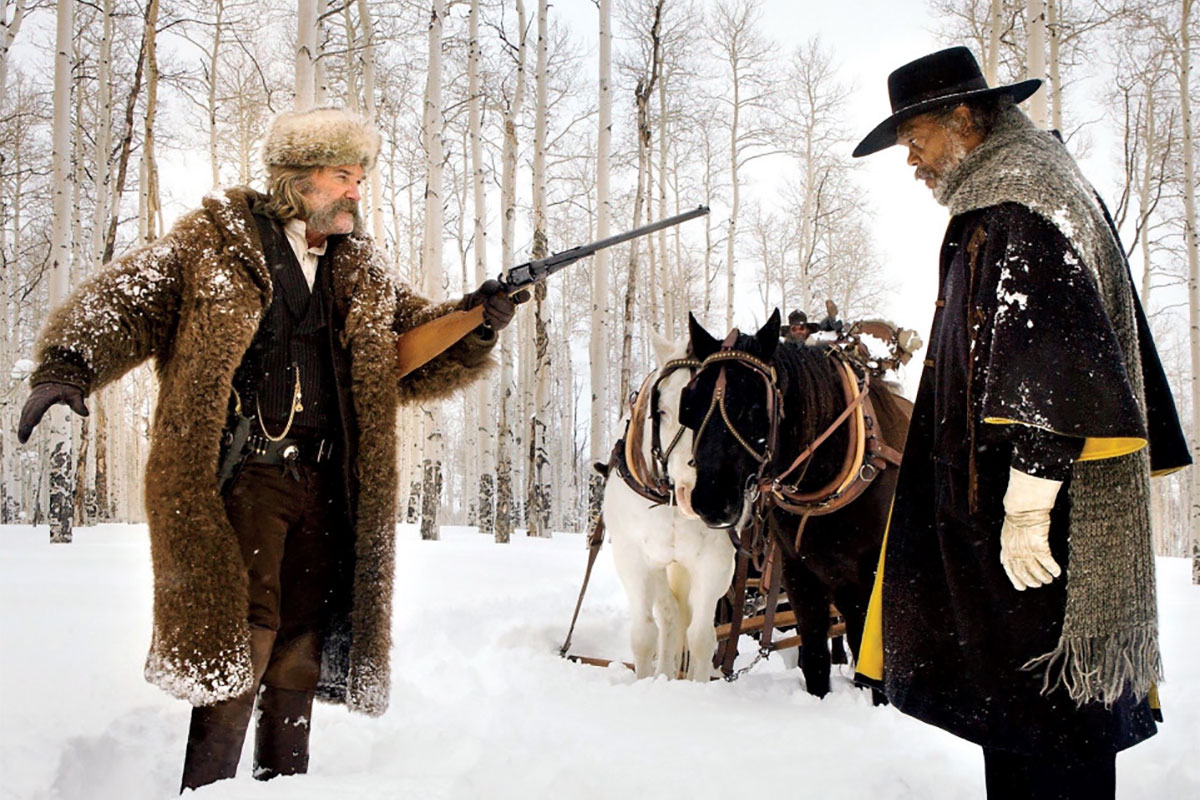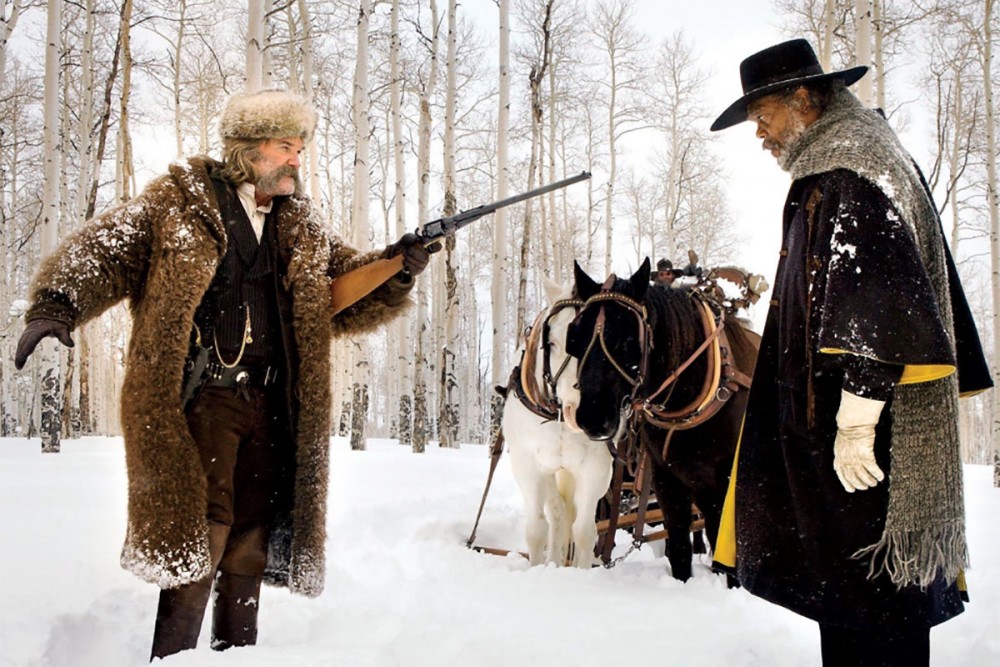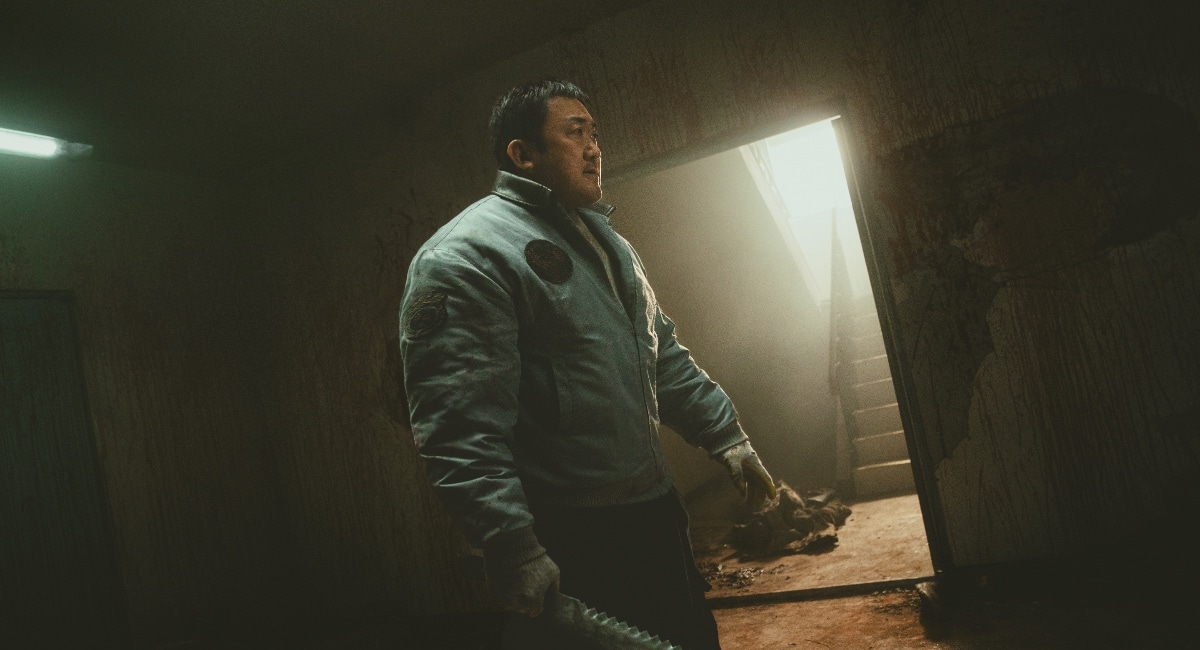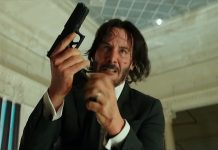There are many that would argue that Quentin Tarantino’s career continues to improve with age. You can count me among that number. While I’ve enjoyed his earlier efforts like Pulp Fiction and Reservoir Dogs, particularly in subsequent rewatches, breaking down their various aesthetics, as I have grown in age my appreciation for new millennial efforts have grown, including my original somewhat colder reception to the Kill Bill duology and Death Proof, finding charm in their full embrace of genre trappings. Frankly, it’s hard to imagine him ever topping Inglorious Basterds, but the ambitious Django Unchained certainly can’t be faulted for trying and standing on its own as a pretty glorious homage to the Spaghetti Western.
The Hateful Eight, his newest, keeps Tarantino rollicking in that same John Ford-inspired territory, but turning it a bit more inward. Rather than the expansive vistas of the Antebellum-era South (and the horrors that were treated as simply matter of fact), here he shifts over to the outwardly hellish toll the Reconstruction era has on its various players and the tension that boils over when those very people are trapped in a snowstorm that leaves them in an all too cramped single room Roadhouse. This may also be his most overtly political feature, particularly given how it shines a light on the past to highlight issues affecting our culture at large today with little of the revenge angle that permeated his previous two meditations in this area.
Originally intended as a sequel to Django Unchained (entitled “Django In White Hell”), turned into a stand-alone and subsequently leaked script that Tarantino shelved, and then finally decided to film after a successful live read; The Hateful Eight opens with Bounty hunters John Ruth (Kurt Russell) and Col. Marquis Warren (Samuel L. Jackson), two men who are markedly different in their approach to their rather dirty jobs – the former takes his bounties in alive and is known as “The Hangman”, the latter prefers them much colder and easier to travel with – find themselves stuck due to the above-mentioned blizzard at Minnie’s Haberdashery. Tagging along for the ride are Ruth’s latest capture, the outlaw Daisy Domergue (Jennifer Jason Leigh, as good as I’ve ever seen her here) and a stranded Chris Mannix (Walton Goggins), the supposed elected sheriff of the town that was their intended final destination. Upon arrival, they’re greeted by four other travelers; a local cow-puncher (Michael Madsen), an actual hangman (Tim Roth), a former Confederate General (Bruce Dern), and the assigned caretaker of the facility (Demian Bichir). To say that the claustrophobic atmosphere produces a sense of conflict and paranoia would be an understatement. Someone may not be who they seem, or perhaps they are. That tension drives the three plus hours that make up the film’s running time.
The Hateful Eight is a bit of an odd beast in its structure. Its opening 45 minutes or so are dedicated solely to its four travelers and establishing their initial dynamic, which is a bit confrontational from the outset (go figure) and leads right from the frying pan and into the fire when they arrive at their point of shelter from the oncoming storm. Those opening chapters, and yes Tarantino is continuing his on-going interest in chapter breaks, are elegantly lensed by longtime collaborator Robert Richardson and provide a beautifully snow-covered counterpoint to the duskier landscapes of their last partnership. Tarantino and Richardson make the most of the 70mm format that’s going to be road-showed this week in time for Christmas in this early going. Once the cast is settled in for the long haul, the much lauded higher resolution format is lost a bit in the more intimate setting as you might expect, but Tarantino wisely tosses enough environmental shots that the use of Ultra Panavision is rewarded for the observant viewer. From a haunting long take with shifting perspectives to every time the cabin-feverish occupants attempt to walk outside, you can rest assured that the 70 mm option is well worth the investment if you have it at your disposal.
In its remaining running time, Tarantino’s eighth feature owes just as much to John Carpenter and Agatha Christie as it does the titans of American gunslinging cinema. The winter based setting finding its forebear in Carpenter’s horror touchstone The Thing, but its commitment to that film’s atmosphere goes beyond mere aesthetics, as it utilizes that same sense of “everyone is a danger and everyone is in danger”. The casting of Kurt Russell as one of your leads certainly doesn’t hurt in that regard. As for the Christie influence, this is where Tarantino’s first real delving into the mystery genre adds to what is maybe Tarantino at his most experimental even though he’s playing to a particularly small stage.
In truth, The Hateful Eight could easily find itself as an Off-Broadway production somewhere, with a setting that is fairly unchanging barring a few short excursions, and performances that are nuanced enough for the screen but could easily be translated to the stage. These type of “filmed plays” often run the risk of becoming a slog (Roman Polanski’s turgid Carnage immediately springs to mind), so it’s to the filmmaker’s credit that not a moment feels wasted and the tension continues to ratchet in every consecutive chapter. In a way, the film is one of his artful protracted scenes – best exemplified by the Michael Fassbender-led basement card game scene in Inglorious Basterds – writ large. You wouldn’t be blamed if you thought that sort of thing couldn’t possibly work for such an extended amount of time, but Tarantino’s great gift is his sense of musical dialogue, along with a volley of deft performances, and his ability to milk a shot for all its worth, it’s easy to see why one may come out of this cinematic onslaught wondering just where the time went.
To focus on the performances, Leigh’s Domergue is probably the best in show, and her essaying of this wild-woman provides a sense of unpredictability, that while even in shackles, as she spends much of the film, strikes a terrifying figure. Both Jackson and Goggins stand as the best of the rest, and these three also provide a sense of the political focus that Tarantino not so subtly points towards. Between Goggins’ Mannix, a former Confederate soldier himself, scoffing at what he deems to be liberal press to Jackson’s Warren diving deep into dialogue on why he feels he’s seen as a threat, there are a number of pertinent points in our current social strata that the scripts begins to dig in at, never going so far as to take over the film in any conceivable way, but playing in the background like a loose accompaniment. Though, it’s possible that the final sequence may cause some discussion in some form or another.
What strikes hardest about The Hateful Eight is how masterfully Tarantino plays with your expectations of character type and where your loyalties may lie. From beginning to end, he pulls his viewers along like a puppet master, asking them “is this who you really want to root for? Oh, you sure you want to get behind this one, instead?”. It’s a brilliant little cat and mouse game between filmmaker and audience from its first frame to its last and makes for one of the essential cinematic experiences of 2015.










Most amazing thing about HATEFUL EIGHT: Tarantino actually got financing for a movie with a 53-year-old lead actress (Jennifer Jason Leigh). I didn’t think such a thing was allowed in Hollywood.
Hi George:
‘Sure’, but the only time anyone is going to know about Leigh if from you post -thats it. I wish my job was not out-sourced to India, so then I would not had relocated to this job I had where my boss fired me after he found out I filed a complaint, because of his abusive behavior, and for consistently treating me like, and for referring to me as literally a ‘dog’ -Colorado is an ’employment at will state’ for temp and contract workers. I bet Tarantino could make a film that could convince me that the USA still actually exists… I bet he is that good of a director, and writer, it would probably be a comedy.
Comments are closed.